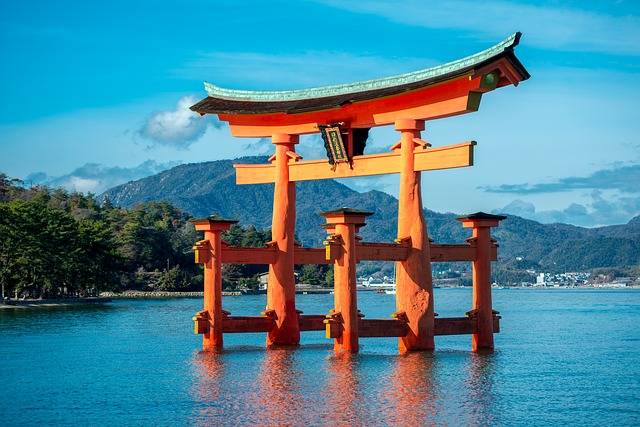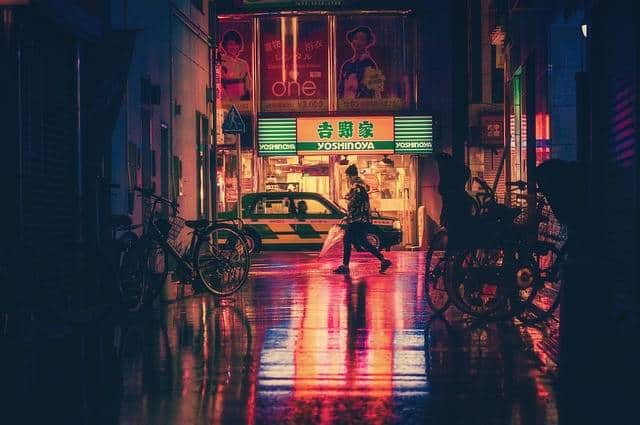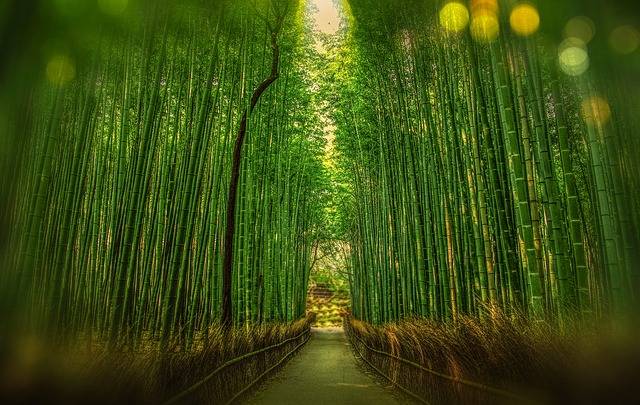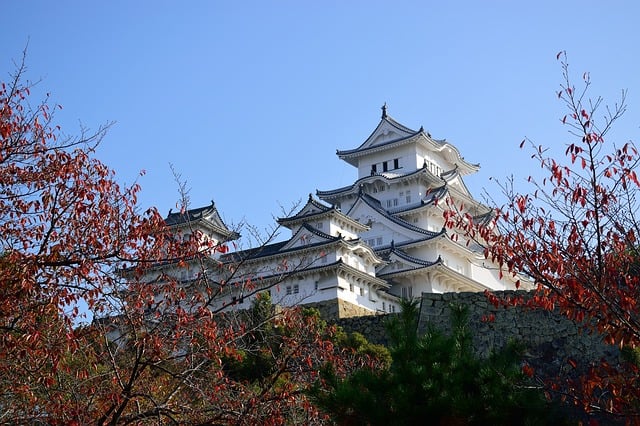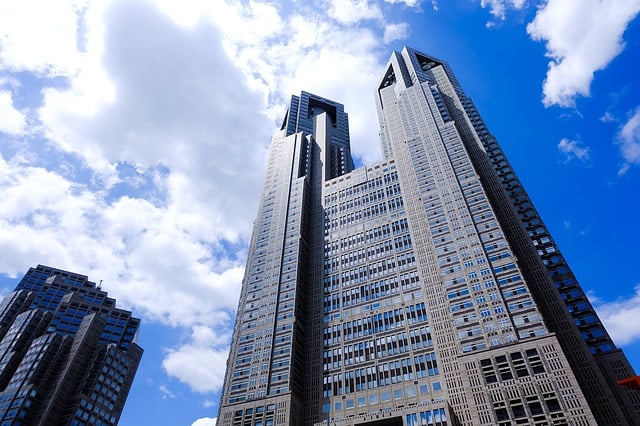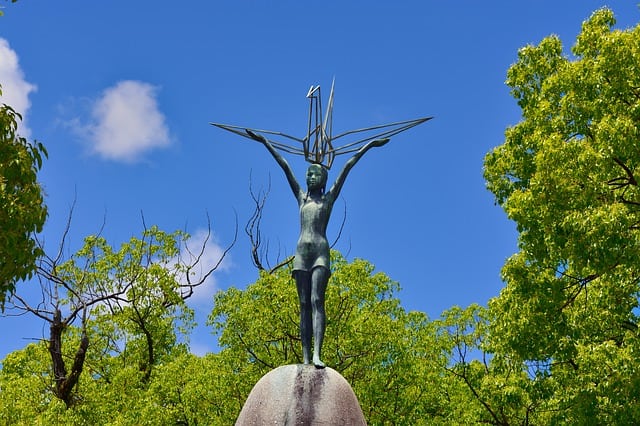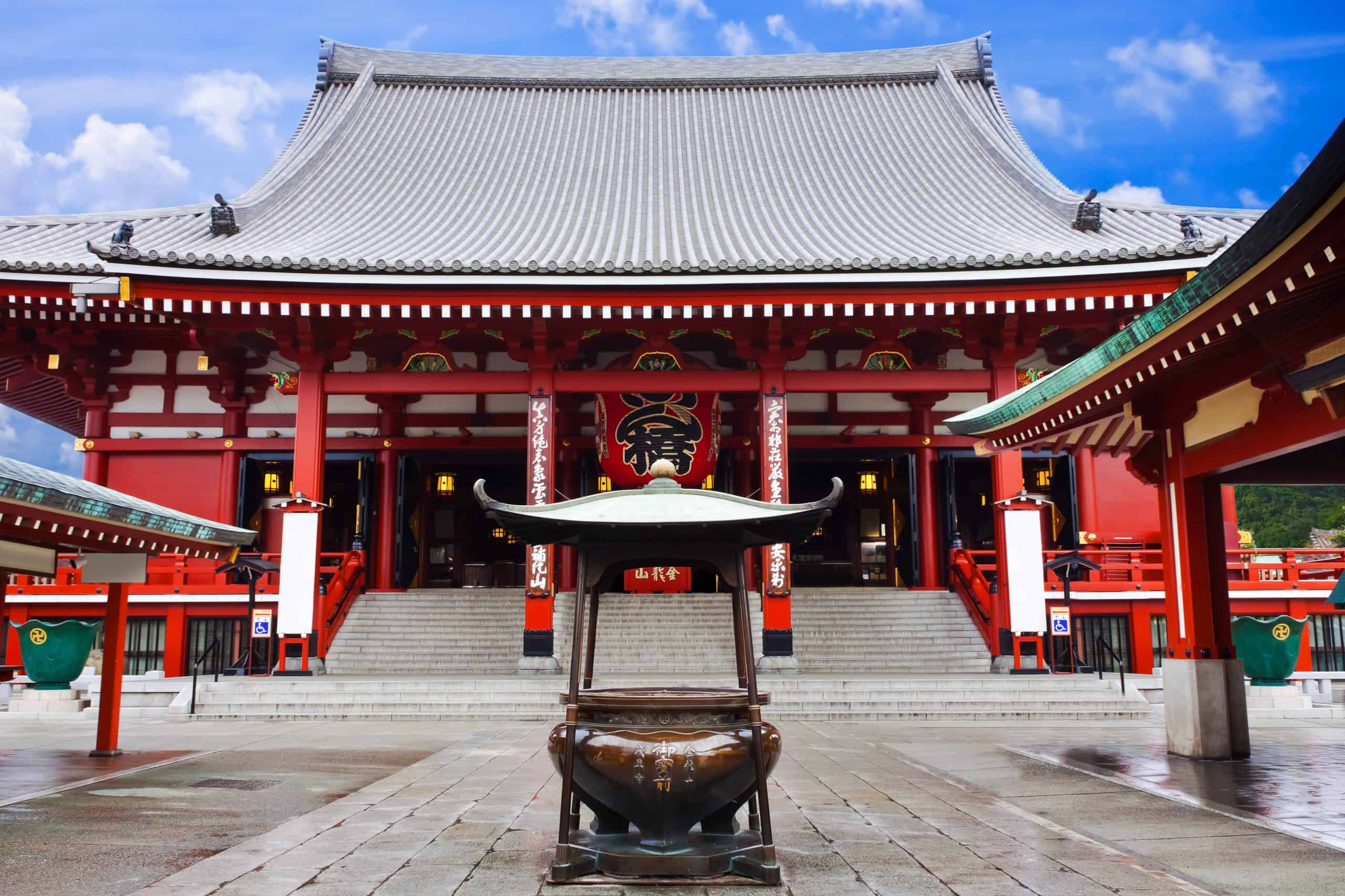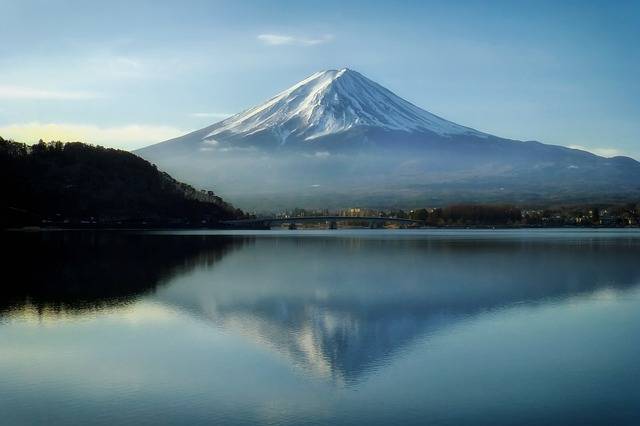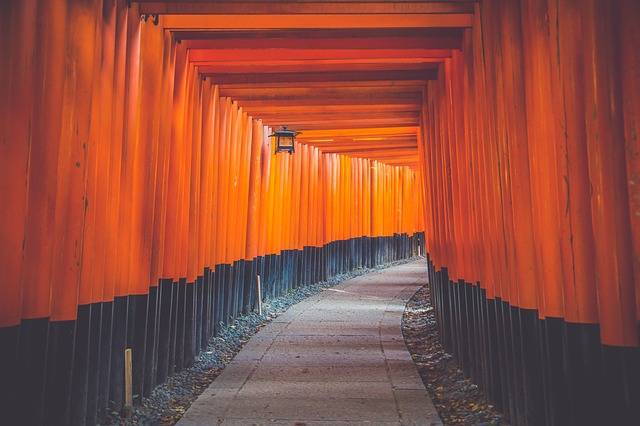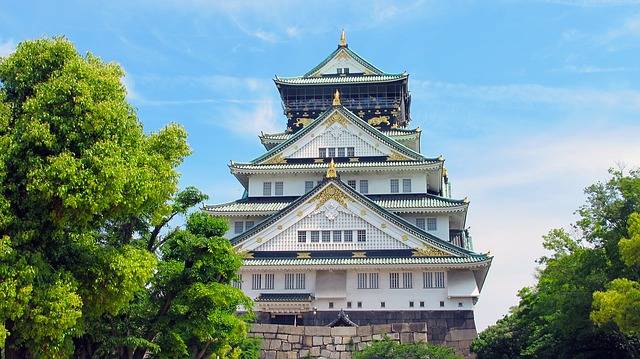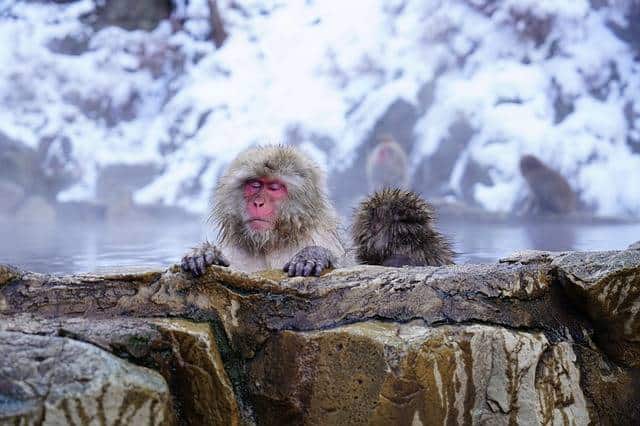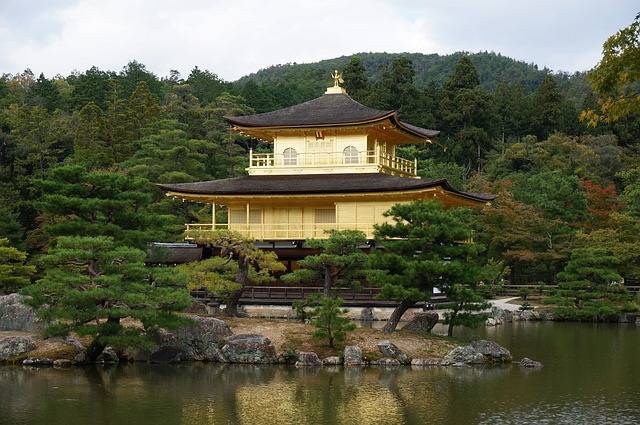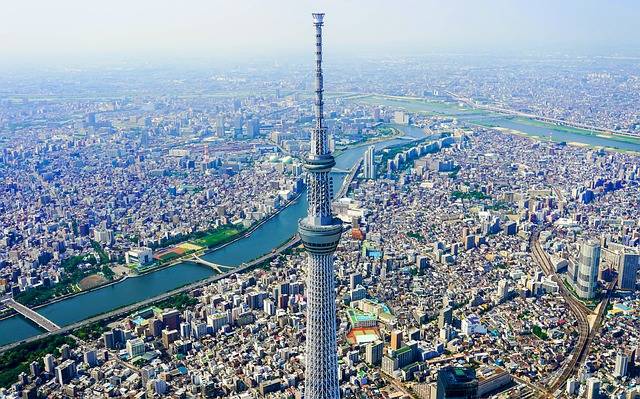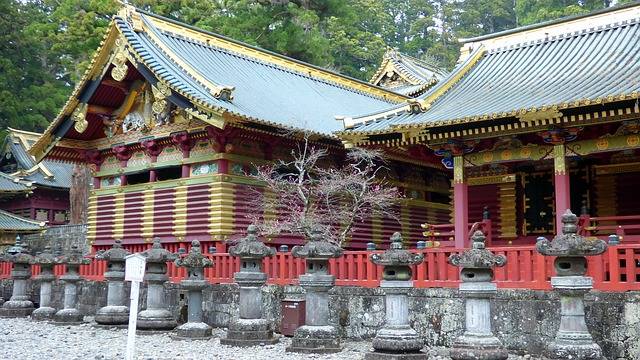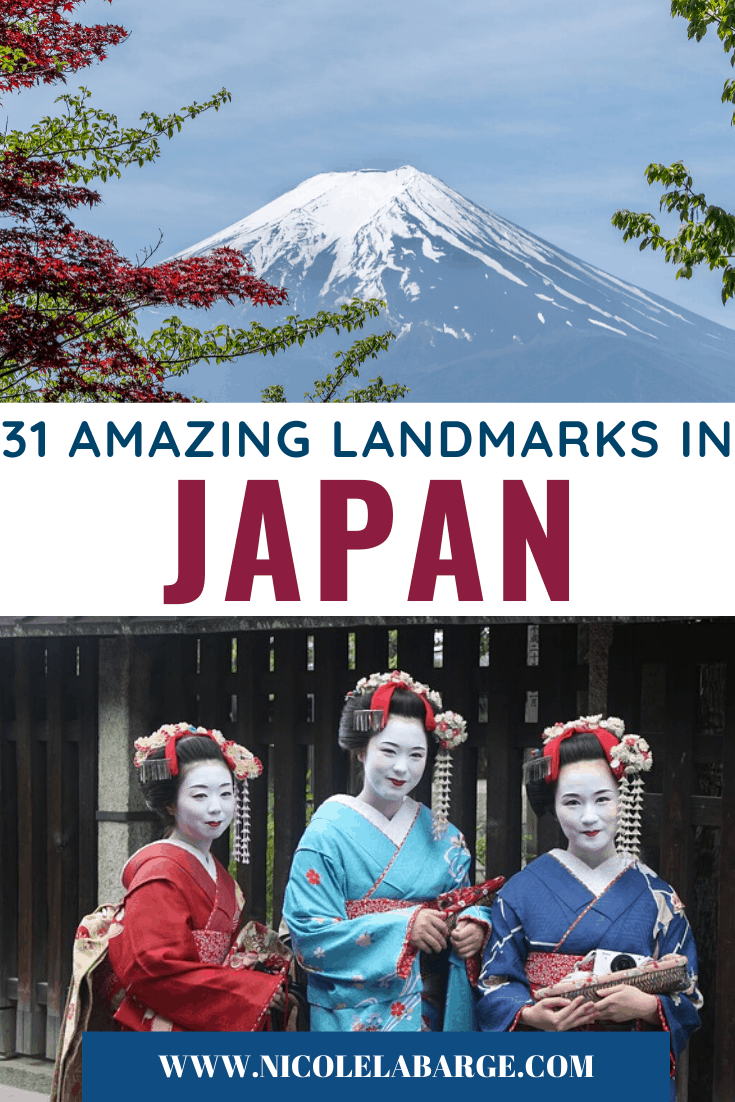31 Famous Landmarks in Japan
Japanese Landmarks that are famous places in Japan
These famous landmarks in Japan will absolutely amaze you. I have put together this list of the major landmarks in Japan and some of my favorite places to visit in Japan.
When you visit Japan, famous landmarks should be on your list of places to visit in Japan. Japanese monuments have a lot of history and culture that you will want to explore while you are in Japan.
This list includes famous Japanese buildings, famous monuments in Japan, Tokyo landmarks, and Japan monuments. Tick these bucket list amazing Japan landmarks off your list.
Japan Landmarks that are Japan historical sites
These Japan landmarks are some of the best Japan Attractions – take it from someone who used to live there.
Arashiyama Bamboo Grove, Kyoto
If you are looking for the most popular landmark of Japan the Arashiyama Bamboo Grove is a must see on any visit to Japan.
The bamboo forest is located in Kyoto and is one of the most photographed sights in the city. Once entered into the forest, there are paved walkways with walking tour directions to lead visitors through the forest and through the soaring bamboos. Also located within this area are the Tenru-ji Temple and the Okochi Sanso Villa. These are both additional must-visit places while on a visit to the bamboo grove.
Although Arashuyama Bamboo Grove is known as being very popular amongst tourists in the city, it does also offer a sense of solitude and peacefulness. Looking down the paths, through the bamboos or up in the sky gives the illusion of an infinite forest filled with beautiful soaring bamboos in all directions. Visiting the Arashuyama Bamboo Grove gives a unique and unforgettable experience to your Japanese visit.
Himeji Castle, Osaka
This castle located in the Kansai region in Osaka, Japan could arguably be the most impressive and best-preserved castle in all of Japan.
The castle itself is estimated to be around 400-years old. More impressive is that it is the only castle in Japan that still remains to be fully intact. Other Castles’ located within Japan have been partially or fully destroyed due to war, construction or other disasters. When visiting the castle grounds, it is hard to miss the beautifully designed and preserved the elevated castle.
When visiting the Himeji Castle, it is recommended to make it a full day trip to be able to fully experience not only the beautiful and historic castle but also get to see the 70+ other buildings located on the castle grounds. Due to the long history of this castle as well as the cultural significance, Himeji Castle was named a UNESCO World Heritage Site in 1993.
Tokyo Metropolitan Government Buildings
Known as Tocho for short, the Tokyo metropolitan government buildings are responsible for governing the towns, cities and villages of Tokyo.
More impressive than the functioning of the buildings is the architect itself as well as the fabulous free observations decks located in both buildings. These observation decks offer grand panoramic views over the whole city including some of the biggest landmarks located in Tokyo. These observation decks also include gift shops and cafes.
Below, on the second story of the building is an information center all about Tokyo, for tourists in the city. the north observatory deck remains open late at night, making it a perfect spot to view the night lights on your visit to Tokyo.
Hiroshima Peace Memorial Park
The park lies on over 120,000 square meters in the center of Hiroshima, Japan.
The location of the park was previously the political and commercial hub of the city, because of this it was the target of atomic bombs in 1945. Following the attacks, the city decided not to rebuild on the land, and instead use it as a place of remembrance and peace. The memorial park is so large, that even if visitors to the city aren’t looking for it, they are likely to walk through it on exertions through the city.
There is a peace memorial museum located within the park which outlines the history of Hiroshima as well as the events and effects of the atomic bomb dropping. Due to the history and importance of the park, it is among the recommended places to see on a visit to Japan.
Senso-Ji Temple, Tokyo
The Senso-Ji Temple is a Buddhist temple and one of the most famous landmarks in Tokyo.
The temple is among thousands in Japan but this one is well known for being the most colorful, most visited and the oldest in Tokyo. Construction of the temple was completed in 645AD and the reasoning for the build was to pay respect to the goddess of Kannon. Upon entering the temple, visitors are met with a 200-metre shopping street which has been located within the temple for several centuries. The shopping street is full of souvenirs, hand-made gifts and local cuisine.
During the war, parts of the temple had been destroyed which led to reconstructions of the temple. Visitors are able to go inside the temple and tour around all year round, and free of cost! There are also many annual events that happen at the temple bringing in more people to capture the history and culture of this unique temple.
Itsukushima Shrine
Itsukushima shrine located on Miyajima island just south of Hiroshima, is a Japan landmark that is famous for its star attraction – the floating torii gate!
The shrine itself is responsible for the island’s fame as millions flock there each year to get a glimpse at the “floating” shrine. This shrine is unique to others in Japan as it appears to have been built over water which gives the illusion to visitors that it is floating atop the sea, during high tide. After sunset, the shrine is illuminated, providing a good backdrop for evening walks or the perfect Instagram photo!
To see the “floating” shrine in person, it is best to plan your trip to the island when the tide is high. However, if the tide is low, the water is gone from the bay and visitors can walk straight up to the gate and get a close glimpse. The shrine and “floating” gate holds a large cultural and historical significance to Japan, so much so that it was named a UNESCO World Heritage Site in 1996.
Mount Fuji
Not only is Mount Fuji the tallest mountain in Japan, coming in at around 3776-metres tall; but it is also a perfectly shaped active volcano that last erupted in 1707. The volcano is located between the cities of Yamanashi and Shizuoka and is so large that on clear days the volcano can be seen from Yokohama and Tokyo.
Getting a perfectly clear view of the mount is often rare due to the large-scale size and the rarity of perfectly clear skies in Japan. However, there are still many spots that you can view the mountain from. There are a few resorts located at the feet of the mount, as well as a train ride from Tokyo to Osaka which often provides the best and most clear view of the mount from the train.
If you wish to attempt the climb of Mount Fuji, you will need to plan your trip for July or August, as these are the only months in which hiking the mount is permitted. This mountain holds large cultural significance in Japan, as it is often worshipped and held to a high standard in the Japanese culture. Due to the significant impact, it was finally named a UNESCO World Heritage Site in 2013.
Shirakawa-go
Shirakawa-go, otherwise known as Shirakawa Village, is the location of a Japanese mountain settlement. The area was previously unexplored due to the natural environment of high mountains and frequent snow.
The environmental conditions in the area led locals to develop unique cultural practices that are still prevalent in today’s Japanese culture. The area is most famous for the traditional farmhouses which are believed to be centuries old. These farmhouses were built to resemble Buddhist culture as well as withstand the strong weather in the regions. The Shirakawa-go region, along with neighboring Gokayama are located along the Shogawa River Valley in the remote mountains in between Gifu and Toyama, Japan.
The farmhouses that the region is famous for now serve as accommodation for those who want to stay in the area to fully experience and appreciate the beauty and cultural experience of Shirakawa-go. Due to the historical and cultural significance of this region, both Shirakawa-go and the neighboring village, Gokayama were named UNESCO World Heritage Sites in 1995.
Ashikaga Flower Park
One of the most loved flowers in japan is the wisteria, also known as the fuji flower.
The Ashikaga Flower Park in Ashikaga City is one of the best places in the country to see the beautiful fuji flowers. The flower park is very colorful, displaying large amounts of blue, pink and white fuji’s; as well as yellow laburnum which is often mistaken for being yellow fujis. The park has many attractions to make any trip there exciting and memorable. One of these attractions includes a huge 100-year old fuji tree in which there is a large umbrella of blue fujis being supported by the tree’s branches.
Another attraction at the park includes a walk-through tunnel entirely made by white fuji flowers. Although the fuji flower seems to be the main attraction to the flower park, there are also many other species of plants and flowers on display. Although the flowers are at its best during spring and summer months, the park still brings in many visitors during the winter months with the LED light show they put on. So, whichever month you decide to visit, the park will not disappoint.
Fushimi Inari Taisha
The Fushimi Inari Taisha is an important cultural shrine located in Kyoto, Japan. The shrine is most famous for the thousands of red torii gates, specifically designed for worship and god fortune.
This specific shrine is the most important of thousands of shrines dedicated to the Inari, the God of rice. Many Japanese and tourists visit this site to worship, pay respect, pray for good fortune and to visit the beautiful grounds the shrine lies on. Located on the grounds are fabulous mountain trails that bring in many tourists to explore. The beginning of the trails are located towards the back of the main grounds.
There are two side-by-side entrances to the trails that begin with entering through a variety of torii gates that have been donated by organizations and individuals over the years. The full trail takes about 3 hours in its entirety. Although, there are many shrines to appreciate along the way as well as many restaurants with traditional dishes on offer. About halfway up, there is a viewpoint where many stops to take in the views over Kyoto.
The Hells of Beppu
A series of spectacular hot pools, located in Beppu, Japan known as the “hells” are not for use but rather purely for viewing. There are seven in total, five of which are located in the Kannawa region while the remaining two are located in the remote Shibaseki district. The hot pools located in the Kannawa district, features a hot mud pool, a milky hot pool, one with demons’ statues around the hot pool, as well as one that homes and breeds crocodiles. The hot pools located in the Shibaseki district features a hot pool containing blood red water and one containing a geyser that erupts boiling water every 30-40 minutes. Almost all the hot pools feature activities to do while visiting. Some feature beautiful gardens to view on the grounds, some feature other spa pools to relax, one features an aquarium and one features a souvenir shop.
Osaka Castle
The Osaka castle was originally built in 1583 on the site where the initial Hongaji Temple had laid and been destroyed over a decade earlier.
When the Osaka castle was built it far outweighed any other and was the largest of the time. however, the castle has been damaged, destroyed and rebuilt several times. In 1997, the castle received modern updates and now stands to be glamorous, beautiful and sophisticated. The castle has many modern features such as elevators and houses many informative centers such as museums.
The grounds of the castle is almost as impressive as the castle itself. The Osaka Castle Park is almost 500 acres and features an impressive garden with over 600 cherry blossom trees – making it the perfect spot to visit during cherry blossom season! The grounds also feature many sporting areas, a public hall and shrine dedicated to worshiping and respecting Toyotomi Hideyoshi – the man responsible for the initial build of the castle.
Daibutsu
Also known as the Great Buddha of Kamakura, Daibatsu is the lesser used formal Japanese name.
The large initially gold statue of Amida buddha stands at 13.4 metres tall and is the second largest buddha in Japan. The statue was created in the 1252 and was initially inside a very large temple. However, over the years the temple had been damaged and destroyed over many centuries, now leading the buddha to stand proudly outside.
The statue sits on the grounds of Kotokuin temple in the Japanese city, Kamakura. the statue holds a large cultural and historical significance to the Japanese, so much so that it has been proposed by the city of Kamakura to be named as a UNESCO World Heritage Site. However, it is yet to be officially included. Visitors to the site can give a small donation for the opportunity to go inside the statue for a unique and unmissable experience.
Jigokudani Monkey Park
Located within the Joshinetsu Kogen National Park along the valley of Yokoyu-River in Yamanouchi, Japan is the Jigokudani Monkey Park.
Within this park, visitors will get a truly unique experience of witnessing wild monkeys bathing in hot spring pools! The monkeys’ native to the area are the Japanese Macaques (also known as snow monkeys!). the park has a man-made hot pool in which the monkeys gather together and bath in the boiling water.
Although, the monkeys also appear all through the park and it is very likely that visitors will see many monkeys along the paths on the way to the pools. Due to the monkeys being accustomed to human interaction, visitors are permitted to get rather close to the monkeys, however they are prohibited to physically touching or feeding the monkey. This experience can be quite entertaining for visitors as monkey behavior can be rather humorous at times.
Kinkaku-ji
Kinkaku-ji, an impressive zen temple featuring two stories covered in gold leaf is located in northern Kyoto, Japan.
The temple was the retirement home of military dictator Ashikaga Yoshimitsu in the early 1400’s. the building itself is rather impressive as well as the land that it’s built on. The temple overlooks a large pond and is surrounded by beautiful gardens. The original buildings of the complex have all been burnt down and destroyed multiple times over the centuries before the current structure was rebuilt in the 1950s.
The temple is the only building to have been rebuilt and the other structures of Yoshimitsu’s retirement villa no longer stand. The grounds of the temple also feature souvenir shops, small restaurants and smaller temples featuring a statue that represents the protector of Buddha.
Tokyo Tower – a famous Tokyo landmarks
Standing at 333metres tall, Tokyo Tower is the largest self-supported steel tower in the world.
The tower was inspired in shape by the Eiffel tower, although the Tokyo Tower stands at an impressive 13metres taller! The tower stands in central Tokyo and construction was completed in 1958, the tower was the tallest in Tokyo until the Tokyo Skytree was completed in 2012 – overtaking the Tokyo Tower in height. The tower is a main tourist attraction in the city however, it doesn’t just function as a tourist destination.
The tower’s main function is as a broadcast antenna for the city of Tokyo. At 150metres tall, the main deck offers great views of the city, glass floors, souvenir shops and cafes. Access to the main deck can either be through the elevator or an impressive 600-step climb up! Even further up, at 250metres, there is a top deck offering great panoramic and birds eye view of the city.
Meiji Jingu Shrine
The Meiji Shrine located Shibuya, Tokyo was built in memory of the first emperor of modern Japan, Emperor Meiji in 1920.
The shrine was unfortunately destroyed during the second world war but was quickly rebuilt following the war. The shrine itself is located on a large forested area complete with over 100,000 trees and many walking paths perfect for daily strolls. At the entrance of the Shrine, there is a large Torri Gate leading visitors into the quiet and tranquil building and wat from the loud busy streets of Tokyo.
The Meiji Shrine is one of the busiest and most popular Shrines in Japan bringing in over 3 million visitors just in the first few days of the year alone! This is also a popular place for Shinto weddings to take place throughout the year, ensuring that any visit could be met with surprise and entertainment.
Kiyomizu-dera Temple
The Kiyomizu-dera Temple translated to “pure water temple” located in Kyoto, Japan is one of the most celebrated and beautiful temples in the country.
The temple was founded in 780AD and has had a long and significant cultural importance to the Japanese since. In fact, due to this importance in 1994 the temple was named a UNESCO World Heritage Site. The temple is most widely known for the large wooden deck surrounding the temple. The deck comes off the main hall and is approximately 13-metres above the below hillside. This deck offers visitors a great view of the many beautiful trees that are planted below – including cherry blossoms and maple trees!
Within the main hall is the temple’s main attraction, a small statue of Kannon. On the grounds of the temple are other attractions too such a shrine dedicated to matchmaking and love and a beautiful waterfall that visitors are invited to drink from as it is believed to bring good luck and fortune to people’s lives.
Nikko Temples and Shrines
Nikko is a small mountain city just north of Tokyo. Nikko is generally most well-known for being the home of the Toshogu – one of Japan’s most lavish and beautifully decorated shrines.
The city of Nikko had previously been a place of Buddhist and Shinto worship prior to the build of Toshogu, in dedication to the founder of Tokugawa shogunate, Tokugawa Ieyasu. The city is also famed for the Nikko National Park which offers breath-taking views of the mountains, lakes, hot pools, wild monkeys and waterfalls in the area.
There are also many hiking trails located in the park for those that want more than just a simple stroll through the park. Nikko also has plenty of other attractions to fulfill any tourist bucket list.
Kyoto Imperial Palace
The Kyoto Imperial Palace is the previous residence of Japan’s imperial family; until Japan’s capital moved from Kyoto to Tokyo in 1868.
The palace is located within the Kyoto Imperial Park which is at the center of the large and busy city. The park not only houses the Kyoto Imperial Palace but also the Sento Imperial Palace as well as a few other attractions. The palace that stands today was not the original building as it was reconstructed in 1855 after it had unfortunately been burnt down and destroyed.
The palace is surrounded by large walls and gates, protecting the palace walls of any potential threat and to preserve the palace. Guided tours are available to tour the palace as well as entering without being part of a guided tour. However, visitors are only permitted to see the palace buildings and gardens as access inside the buildings are not allowed.
Onbashi Natural Bridge
Onbashi is a beautiful scenic spot and a natural monument in Shobara, Japan.
Taishaku Gorge is an area that hosts many natural wonders and Onbashi is arguably the most impressive and most popular. The bridge, formed over the course of thousands of years is 40-metres high, cut from limestone and hovers over the Taishaku river.
Although the bridge was functional long ago, allowing people to walk over, it now no longer serves as a functioning bridge. This likely could be due to the desire to preserve the bridge as much as possible. However, there are paths that lead below the bridge, allowing visitors a close look at the beautiful and natural creation. Additionally, the bridge is also among the top three of the largest natural bridges in the world.
Hagoromo Falls
The Hagoromo Waterfalls is located in the Daisetsuzan National Park in Hokkaido, Japan and is one of the most impressive natural waterfalls you could see.
The waterfall is believed to drop approximately 270-metres down over multiple steps, which according to some gives the illusion of an angel’s robe – the English translation of the waterfall is “angel’s robe falls”.
This is the only natural waterfall available in the area, as access to the other one has since been closed due to wild bears in the area. However, there are a few man-made waterfalls scattered throughout the park as well. The waterfall is within a short walking distance to the Tenninkyo Onsen as well as the hot springs town where there is an observation deck in which the Hagoromo Waterfall is clearly visible; as well as the other natural waterfall which is closed to public entry.
Hakone Hot Springs and Onsen
Hakone is a mountain town just west of Tokyo and has been the most popular spot in Japan for hot pools for the last few centuries.
There are currently over a dozen hot pools that provide hot spring water to all the nearby bath houses and traditional Japanese inns known as Ryokans’. There are a combination of both outdoor and indoor hot springs as well as ones open to all public members and some that are generally populated with staying guests.
These hot pools are at the Ryokans where guests can enjoy the amazing hot springs free of charge while day visitors to the area pay a small fee to jump in on the fun in the hot springs.
Odawara Castle
Also in the small mountain town of Hakone is the Odawara Castle! The castle has a long history including beginning its days as being the base of one of the most powerful clans during the 1500s controlling Tokyo.
In 1590, the castle was attacked, defeating the clan and reuniting the country. Over the years since the castle has been damaged, destroyed and rebuilt several times. Also on the castle grounds is three large gates in front of the castle – these aren’t just regular gates however, their castle keep!
Inside the castle keep there are history exhibits about the castle as well as items displayed that hold special significance to the castle and its history. There is also a museum located on the grounds which gives visitors an even greater background to the castle. The castle grounds is also a top spot to see cherry blossoms when they’re in season.
Kanazawa Castle Park
Kanazawa Castle was also home to a powerful clan during the 1500s before getting its ownership and power back by the Japanese people.
The castle itself however has been destroyed and burnt down several times over the centuries and reconstruction on the castle has been a long process of which it is still going on today! The castle’s reconstruction makes for an interesting stop for visitors as many get to see the process up close and see what goes into the re-build of an ancient and historic building.
The castle itself is located on the Kanazawa Castle Park which is an absolutely beautiful large park in the center of Kanazawa. The park features not only the newly reconstructed castle but other new buildings that hold significance to the castle, culture and history alike.
Kennin Ji Temple
The Kenninji Temple is located in southern Kyoto and is used as one of the main temples for Japanese Buddhism.
The temple is also considered to be on the list of the five best Zen temples in Kyoto. The temple was constructed in 1202, making it the oldest temple in the city! The temple was founded by the man who introduced Zen Buddhism to Japan – thus making it a culturally significant temple as well as a historically significant one.
The main hall of the temple, as well as the smaller buildings surrounding the main temple, are open to the public year-round, allowing visitors to explore through the interiors of the temple during their visit. When exploring the interiors, visitors will get to admire the unique dragon murals that are inscribed into the ceilings and sliding doors within the temples. For a variety of reasons, this temple stands out to the others, making it on the top of many must visit lists.
Mozu-Furuichi Kofun
In the region of Osaka, Japan are dramatic and architecturally brilliant tombs, left by the first rulers of Japan to show of their power and money.
In total there are a few dozen tombs which are the largest tombs in Japan and among the largest in the world. Due to the significant cultural importance of these tombs, in 2019 the site was named as a UNESCO World Heritage Site in an effort to protect the site and preserve it from any possible future issues.
The tombs themselves were built during the 4th-5th centuries and were specifically designed for the Japanese elite. The large size and impressive shape were purposefully made in an effort to separate from the smaller tombs made for people of lower status. The largest of the tombs is estimated to be about 800m x 600m and is believed to be the tomb for the ancient emperor, Nintoku.
The site where the tombs are is not often open to the public in an effort to keep them safe from potential ruin. Due to the large size of the tombs it is also very difficult to fully appreciate as not often can you see the tomb in its entirety unless situated on a very high viewpoint.
Akashi Kaikyo Bridge
The Akashi Kaikyo Bridge situated along the Akashi straight between Awaji and Kobe is almost 4-km long and is officially the longest suspense bridge in the world.
Construction on the bridge took an entire decade to complete, and the bridge was officially finished and opened to the public in 1998. There is a bridge exhibition center on the Kobe end of the bridge which gives visitors a look at the construction process of the bridge as well as comparisons of the bridge to other suspense bridges around the world.
There are also pathways inside the bridge which, allowing visitors to walk through and have an up-close look at the interiors – a unique experience unlike any other.
Tokyo Imperial Palace
This is the current imperial palace in Japan, and it is located in Tokyo on the grounds of a large beautiful park surrounded by large stone walls and moats.
The park that the palace is located on is in a central area and very close to the Tokyo train stations – makes perfect for a visit if staying in Tokyo. The site of the castle is the site of the previous Edo castle which was present during the 17th-19th centuries until the capital got moved to Tokyo and this became the site of the Imperial Residence. In 1888 the new construction was completed; however, it was destroyed during the second world war and construction was again began.
The public entrance into the palace is generally not permitted aside from special occasions throughout the year. However, the palace grounds are spectacular and still provide views of the palace regardless of the entrance. Thus, still making it a worthwhile visit during a stay in Tokyo.
Tsumago
Tsumago is the best-preserved post town in Japan. The residences of the town are always ensuring that the town continues to resemble how it did during the ancient Edo period.
This is done by not allowing cars to be driven on the main road and having all power cables and phone lines kept hidden from public views. By doing this, people who live in the town and those are that just visiting are gaining a truly unique experience by feeling as if they are traveling back in time.
There are a few ryokans in the town allowing for visitors to stay overnight, providing a longer illusion to the ancient times.
Nagasaki Peace Park
Nagasaki Peace Park is a place of respect and memory for those thousands of people who were killed during the August 9th atomic bombings in 1945.
In the center of the park there is a simple long piece of black stone that signifies the center of the explosion. The park is a tranquil area where visitors can pay respect to those who lost their lives. There are still areas of the park where the remains of the explosion remain such as broken tiles, bricks and glass.
Also located within the park is the Atomic Bomb Museum. This museum has a goal of informing all people, specifically younger and future generations on war and the danger and heartbreak it causes. There is also a victim memorial hall, located underground and dedicated to the tens of thousands of people who tragically lost their lives. The park is a beautifully kept and preserved the place of remembrance; but also designed for visitors to come and relax, have fun and experience some tranquillity within the busy city.
Conclusion
These are the best Japan Landmarks around the country. Each time I go back to Japan I try to visit a new area and find new places and Japanese Landmarks to see.
Which landmark in Japan is your favorite?
Sharing is Caring! Pin this article to save for later
Read more Japan Articles on my website:
My 10 Day Itinerary Japan is perfect for those who are visiting Japan the first time
I have another itinerary focusing on Tokyo, Kyoto, Osaka Japan Itinerary
My detailed Osaka 2 Day Itinerary
Visiting the Kyoto Temples – which ones are best?
The Best Japan Travel apps you will need for your Japan Vacation
Recent Posts
Welcome to the enchanting world of Óbidos, a medieval gem nestled in the heart of Portugal. If you are wondering what to do in Obidos, you are in the right place. This list of best things to do in...
15 Best Things to do in Nazare: Guide to Portugal's Surf Paradise
Embracing Nazaré’s Coastal Charm Nestled along Portugal's Silver Coast, Nazaré is a picturesque fishing village that has recently soared in popularity, not just for its rich history but for...

